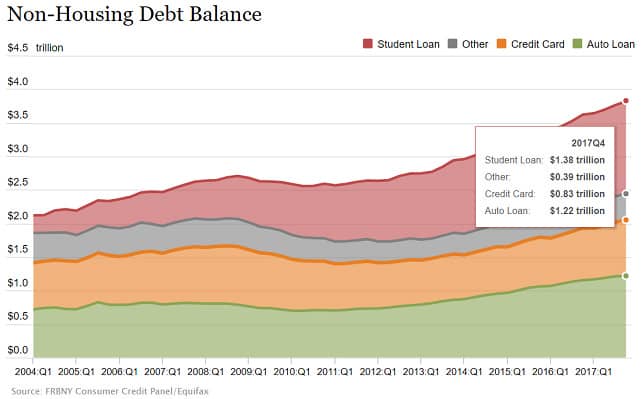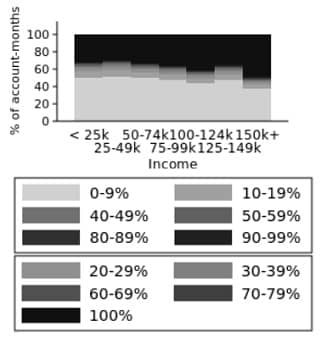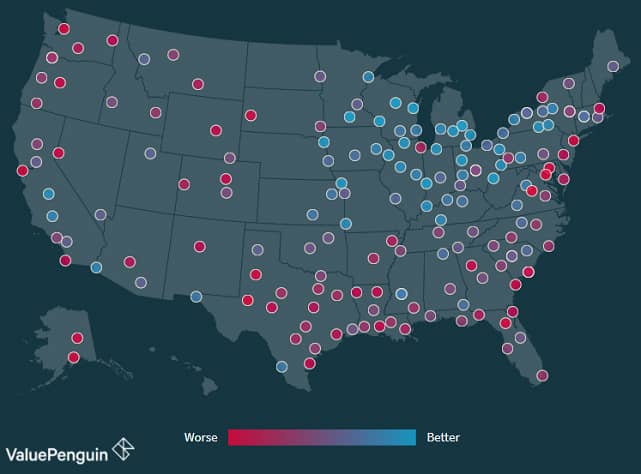Let’s talk about credit card debt statistics. March of 2018 saw the sixth rise of the federal funds rate — and, thus, the U.S. Prime Rate — since 2015, a marker of the continued growth of the U.S. economy since its lows in the late 2000s.
But while economists may hail the increase as a positive sign, average consumers may not feel so positive about an increase in their interest rates — particularly not the 50% of consumers with credit card debt that just got more expensive.
And we’re not talking about an insignificant amount of debt, either. Total revolving debt in the U.S. has reached an all-time high, coming in just a little under $1.03 trillion by the end of January. Keep reading as we explore this important topic in further detail and offer several options that may help consumers pay off their debt faster, including credit cards and personal loans.
What We Owe | Who Owes It | Paying It Off
Total U.S. Credit Card Debt is Over $830 Billion
Of the more than $1 trillion worth of revolving debt balances Americans are carrying in 2018, the vast majority is credit card debt. The total amount of debt carried as credit card balances hit $830 billion at the end of 2017.
While not an all-time high, the $26 billion jump to the $830 billion mark in the fourth quarter of last year was the third such increase in 2017, giving a total annual increase of $50 billion since the end of 2016.

This graph from the Federal Reserve Bank of New York’s Center for Microeconomic Data shows the non-housing debt balances by debt type.
Given the 126.2 million American households, the average household has around $8,161 in revolving debt, approximately $6,577 of which is credit card debt. With nearly 248 million Americans over the age of 18, that comes out to a total of $3,353 in credit card balances per U.S. adult.
Of course, not every consumer carries a credit card; only around 70% of Americans have at least one card, which amounts to about 173 million cardholders over the age of 18. Spread out among those with credit cards alone, the average cardholder has approximately $4,789 in credit card balances.
Credit Card Debt Statistics Broken Down by Category
For some of the consumers holding credit card debt, that debt is fleeting; one study found that an average of 39% of cardholders always pay their credit balances in full each month.

The Consumer Financial Protection Bureau (CFPB) survey shows less than 40% of consumers always pay credit card balances in full.
At the same time, around 29% of cardholders make low payments at or near the minimum payment most months. But it’s not always the consumers you think it will be.
For example, while those with FICO credit scores above 700 are certainly more likely to pay their full credit card balance every cycle, even those with scores above 800 will make a low payment around 20% of the time.
Overall, the amount of debt seems to be the best indicator of how much is paid, with balances under $1,500 more likely to be paid in full, and those over $2,000 more likely to receive just the minimum payment. Other patterns in the data emerge when looking at factors like income, age, and region.
Credit Card Debt: Income & Employment
The correlations between income and credit card debt seem to show that money doesn’t necessarily buy debt freedom. In fact, average credit card debt appears to increase with annual income, and those with the largest income have the highest credit card balances.

This chart from the paper “Minimum Payments and Debt Paydown in Consumer Credit Cards” shows the correlation between income and tendency to pay balances in full.
Similarly, credit card debt may also be a factor of household net worth at both ends of the spectrum. , Those with the highest net worth households carry almost the most debt — with the exception of $0 net worth households, who carry the most.
As might be expected, those with the highest incomes — $150,000+ annually — are the most likely to pay their credit card balance in full each month. However, they may still make minimum or near-minimum payments as much as 38% of the time.
In comparison, those with incomes less than $50,000 will make low payments about 50% of the time. Cardholders with incomes less than $25,000 are the least likely to pay in full.
Credit Card Debt: Age & Gender
While not as obvious a factor as income, age also seems to be a correlating element, with older consumers more likely to pay their credit cards in full, and middle-aged consumers equally likely to pay in full as make the minimum payment.
And likely with good reason, given that those consumers between 35 and 65 are also carrying the most credit card debt, particularly from ages 45 to 54. (On the plus side, credit scores also seem to rise with age.)

Data from Experian’s State of Credit: 2017 shows the middle generations carry the most credit card debt.
A good portion of the correlations between age and credit card debt is likely due to the cost of living, as those in their middle adult years are more likely to have home-related expenses and have dependents than those in older and younger demographics. Homeowners tended to pay twice as much credit card interest per year as renters.
The role of gender in credit card debt is more variable, with one survey saying men carried more debt, and others saying women are the more frequent debt holders.
Experian’s data — which, arguably, is bound to be the broadest-based — says that men and women both have an average revolving debt ratio of 29.9%, though women have 3.7% less average debt than their male counterparts. (Women also tend to have better credit scores.)
Credit Card Debt: Region
Another interesting credit card debt influence was found to be location, with regional patterns in both the amount of credit card debt as well as the average credit score.
The Midwest and Great Lakes regions seem to be where to find the most responsible credit card users, home to both the lowest average credit card debts and the highest average credit scores (which belong to Iowa and Minnesota, respectively).

ValuePenguin’s chart shows the states with the highest and lowest average credit card debt.
That said, the New England area also shows lower credit card debt numbers than other regions, as well as being home to three of the 10 states with the highest average credit scores.
Alaska is home to the consumers with the highest average credit card debts, sporting more than 20% more debt than the next-highest state of Colorado, though Alaska’s credit scores tend to be middling. The lowest credit scores of all are found in Mississippi.
While Alaska has the highest debt, the trend of high credit card debt is definitely most prominent across the southern and western states. The South is also where most of the lowest credit scores are found.
The Numbers on Getting Rid of Debt
Despite the large amount of credit card debt most of us seem to carry, the actual number of cardholders defaulting on that debt remains fairly low — hovering around 2.5% — which is especially good when compared to post-recession highs.
For those consumers who make up the large number of people paying less than their full balance each month, there are several ways to make your monthly payments more affordable.
89% of Credit Cards Offer Balance Transfers
One popular method of making credit card debt more affordable is to lower your interest rate, thus decreasing the fees you’re charged each month.
If you just need a small drop or have shown credit improvements since you got your card, you may have success requesting a lower rate from your issuer; one study found 69% of people were able to negotiate a lower rate with their issuer.
If this doesn’t work or you want an even lower rate, one of the easiest ways is to make a balance transfer to a card with a 0% APR offer.
+See Our Top-Rated Balance Transfer Cards
The vast majority of credit cards — 89%, to be exact — will allow balance transfers, and around 41% of cards offer lower introductory interest rates to new cardholders.
One thing to watch out for, however, is that balance transfers will almost always come with fees. Only about 9% of credit cards don’t charge a balance transfer fee, which means you could be stuck paying 3% to 5% of your total transferred balance as a fee for the service. So, if you’re considering a balance transfer as the solution to making your debt more manageable, just remember to factor in any balance transfer fees that may accompany the card you’re using.
52% of People with More Than $6,000 in Credit Card Debt Have Consolidated
If a balance transfer won’t cut it, the next best thing may be to consolidate your credit card debt with a personal installment loan. This may be the case particularly if you have too much debt for a balance transfer, or if your credit won’t qualify you for a decent offer.
In most cases, installment loans can offer significantly lower interest rates than a typical credit card, though your rate will depend on your credit. Using an online lending network, like our picks below, can help you find the lowest rates for you by connecting you with multiple lenders at once.
- Loan amounts range from $1,000 to $35,000
- All credit types welcome to apply
- Lending partners in all 50 states
- Loans can be used for any purpose
- Fast online approval
- Funding in as few as 24 hours
- Loan amounts range from $500 to $10,000
- Compare quotes from a network of lenders
- Flexible credit requirements
- Easy online application & 5-minute approval
- Funding in as few as 24 hours
- Loan amounts range from $1,000 to $35,000
- Flexible credit requirements
- Loans can be used for anything
- Five minute application
- Funding possible in as few as 24 hours
- Large lending network with multiple partners
Successful credit card consolidation can not only reduce your interest rate and monthly payments, but can also turn multiple credit card payments into a single loan payment, simplifying your finances.
As a result, as much as 52% of consumers with $6,000 or more in credit card debt have used consolidation to make debt repayment easier.
The biggest reason those with high debt avoid consolidation is the fear that it will negatively impact their credit scores (25% of respondents), while worries about getting scammed are also strong (24% of respondents).
In both cases, being sure to do your research before embarking on your credit consolidation journey can help allay your fears and smooth the process. Always investigate a financial institution before entering into an agreement.
Avoid Becoming Yet Another Credit Card Debt Statistic
The federal funds rate is set to rise at least twice more in 2018, which will almost assuredly mean corresponding increases in the U.S. Prime Rate upon which variable APRs are based.
But while the increases are a sign of a growing economy, they also come at a time when we have a steady growth of credit card debt, and each increase can make that debt more expensive to carry — and to repay.
To avoid becoming a negative credit card debt statistic, be sure to always use your credit cards wisely, including paying in full (and on time) each month. Healthy credit card habits can build your credit profile and make your financial life easier, turning you into a good credit card statistic.
Advertiser Disclosure
CardRates.com is a free online resource that offers valuable content and comparison services to users. To keep this resource 100% free, we receive compensation for referrals for many of the offers listed on the site. Along with key review factors, this compensation may impact how and where products appear across CardRates.com (including, for example, the order in which they appear). CardRates.com does not include the entire universe of available offers. Editorial opinions expressed on the site are strictly our own and are not provided, endorsed, or approved by advertisers.





![21 Eye-Opening Student Debt Statistics ([current_year]) 21 Eye-Opening Student Debt Statistics ([current_year])](https://www.cardrates.com/images/uploads/2020/11/shutterstock_674141887.jpg?width=158&height=120&fit=crop)

![Average Credit Card Debt in American Households ([current_year]) Average Credit Card Debt in American Households ([current_year])](https://www.cardrates.com/images/uploads/2018/01/avgdebt.png?width=158&height=120&fit=crop)
![Average Credit Card Debt by Age in [current_year] Average Credit Card Debt by Age in [current_year]](https://www.cardrates.com/images/uploads/2023/05/CR-AverageCreditCardDebtbyAge.jpg?width=158&height=120&fit=crop)
![Average Credit Card Debt by State in [current_year] Average Credit Card Debt by State in [current_year]](https://www.cardrates.com/images/uploads/2023/06/CR-AverageCreditCardDebtbyState-1250X650.jpg?width=158&height=120&fit=crop)
![Average Credit Card Debt by Country in [current_year] Average Credit Card Debt by Country in [current_year]](https://www.cardrates.com/images/uploads/2023/06/CR-AverageCreditCardDebtbyCountry-1250X650.jpg?width=158&height=120&fit=crop)
![Average Credit Card Debt By US Household in [current_year] Average Credit Card Debt By US Household in [current_year]](https://www.cardrates.com/images/uploads/2023/06/CR-AverageCreditCardDebtbyHousehold-1250X650.jpg?width=158&height=120&fit=crop)
![Average Credit Card Debt in America in [current_year] Average Credit Card Debt in America in [current_year]](https://www.cardrates.com/images/uploads/2023/06/CR-AverageCreditCardDebtInAmerica-1250X650.jpg?width=158&height=120&fit=crop)